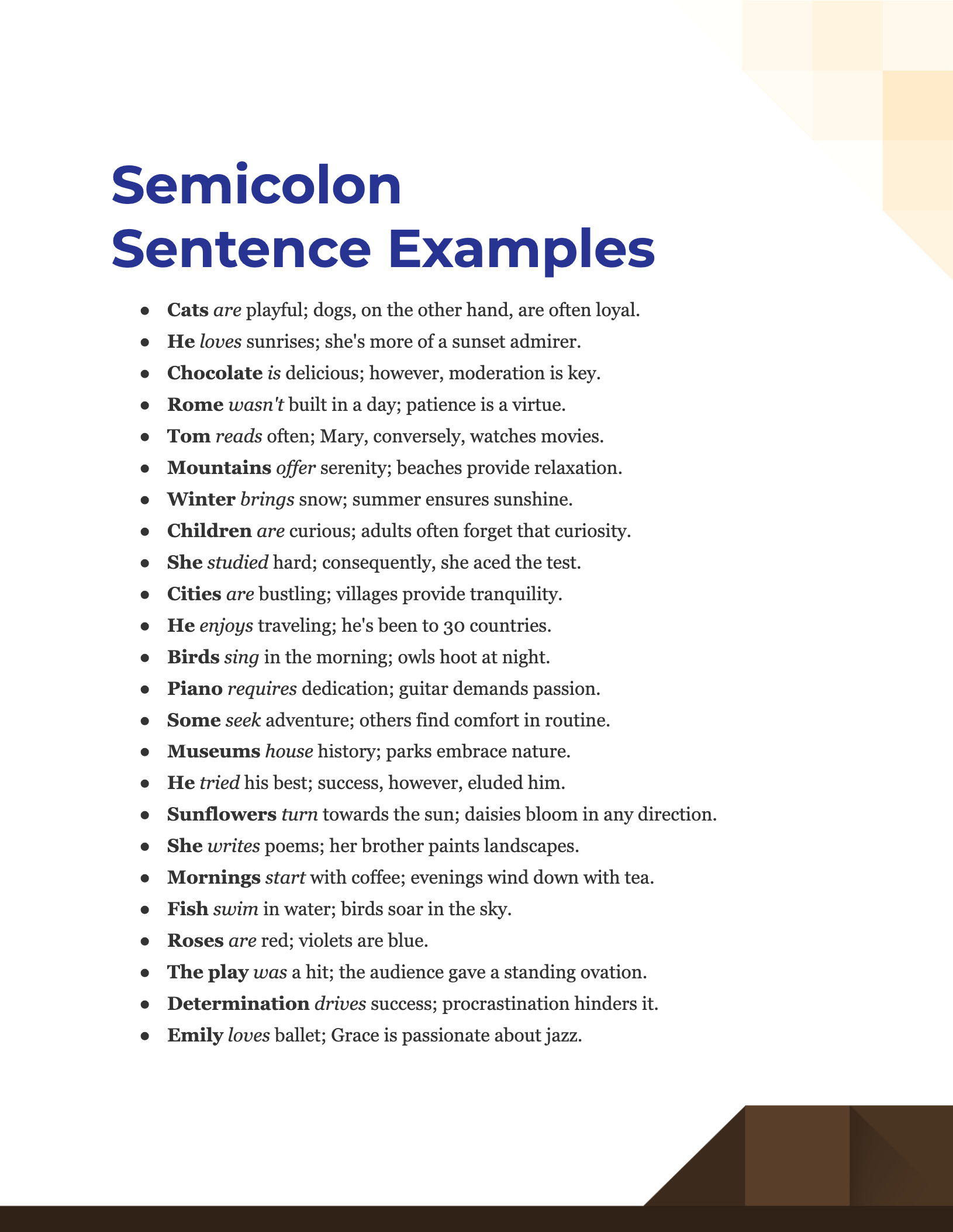99+ Semicolon Sentence Examples
The semicolon, an often-misunderstood punctuation mark, acts as a bridge in the world of writing, seamlessly connecting related ideas. Its artful application can elevate your sentences, providing clarity and sophistication. This guide illuminates the nuances of semicolon usage through illustrative examples, offering invaluable insights and best practices for harnessing its potential. Whether you’re a novice or a seasoned writer, dive in to perfect your punctuation game.
What is the Semicolon Sentence? – Definition
A semicolon sentence employs the semicolon (;) punctuation mark to link two closely related independent clauses. Instead of separating these clauses with a conjunction or period, the semicolon merges them, emphasizing their interconnectedness and preserving the flow.
What is the best Example of a Semicolon Sentence?
One of the quintessential examples of a semicolon sentence is: “Life is short; make the most of it.” Here, both clauses can stand alone as complete sentences. Yet, by using a semicolon, the writer draws a direct connection between the brevity of life and the urgency to make the most of it, emphasizing the relationship between the two thoughts.
100 Semicolon Sentence Examples

Semicolons serve as pivotal connectors in writing; these versatile punctuation marks elegantly link related clauses. By understanding their role, writers can craft sentences that radiate depth and cohesion. Our handpicked list showcases 100 exemplary semicolon-infused sentences. Delve into these examples to refine your semicolon proficiency and elevate your compositions.
Note: Subject Indicated as bold, Verb Indicated as Italic.
- Cats are playful; dogs, on the other hand, are often loyal.
- He loves sunrises; she’s more of a sunset admirer.
- Chocolate is delicious; however, moderation is key.
- Rome wasn’t built in a day; patience is a virtue.
- Tom reads often; Mary, conversely, watches movies.
- Mountains offer serenity; beaches provide relaxation.
- Winter brings snow; summer ensures sunshine.
- Children are curious; adults often forget that curiosity.
- She studied hard; consequently, she aced the test.
- Cities are bustling; villages provide tranquility.
- He enjoys traveling; he’s been to 30 countries.
- Birds sing in the morning; owls hoot at night.
- Piano requires dedication; guitar demands passion.
- Some seek adventure; others find comfort in routine.
- Museums house history; parks embrace nature.
- He tried his best; success, however, eluded him.
- Sunflowers turn towards the sun; daisies bloom in any direction.
- She writes poems; her brother paints landscapes.
- Mornings start with coffee; evenings wind down with tea.
- Fish swim in water; birds soar in the sky.
- Roses are red; violets are blue.
- The play was a hit; the audience gave a standing ovation.
- Determination drives success; procrastination hinders it.
- Emily loves ballet; Grace is passionate about jazz.
- He believes in aliens; she thinks it’s pure fiction.
- Stars shine brightly at night; the moon adds to the spectacle.
- Life is unpredictable; every moment counts.
- Novels transport us to different worlds; poetry captures emotions.
- Wine complements a meal; water refreshes the soul.
- Gold gleams; silver has its own subtle shimmer.
- Apples are sweet; lemons have a tart taste.
- He chose the path less traveled; it made all the difference.
- Winter has its chill; spring brings warmth.
- Honesty is appreciated; deceit breaks trust.
- Jazz sways the heart; rock stirs the spirit.
- Elephants are mighty; ants showcase strength in numbers.
- Time flies; memories remain.
- Mountains challenge climbers; valleys offer respite.
- Chocolate melts in heat; ice cream quickly follows suit.
- He prefers silence; she thrives in chaos.
- Nature heals; the city inspires.
- History teaches us; the future awaits our actions.
- She wears her scars proudly; they tell her story.
- Deserts are vast and open; forests are dense and mysterious.
- Mangoes taste divine in summer; oranges are winter’s delight.
- John adores classical music; Alice grooves to pop hits.
- Computers have revolutionized our lives; smartphones made them portable.
- Rain brings relief to parched lands; it sometimes causes floods.
- Daisies bloom in spring; roses are perennial favorites.
- Waterfalls cascade with power; streams flow with gentle grace.
- He searches for meaning; life offers myriad experiences.
- Children dream without boundaries; adults often set them.
- Books store knowledge; readers unlock it.
- Grapes can be sweet; some are sour.
- Art expresses emotions; music amplifies them.
- She savors every moment; life is a fleeting journey.
- Birds migrate for seasons; humans travel for experiences.
- He cherishes old memories; she creates new ones daily.
- Languages differ across regions; emotions are universal.
- He is introverted by nature; his actions speak volumes.
- Cities breathe life at night; countryside rests under the stars.
- The sun sets; twilight embraces the horizon.
- Actors perform on stage; directors shape the vision.
- Rainbows appear after rain; sunshine brings them to life.
- She writes in cursive; he types swiftly.
- Diamonds are precious; friendships are priceless.
- Music transcends boundaries; rhythms unite souls.
- Days are hectic; nights offer solace.
- Trains whistle along tracks; cars zoom on roads.
- Penguins waddle on ice; dolphins glide in the sea.
- He sips his tea slowly; she gulps down coffee.
- Snow blankets the earth; flowers carpet the spring.
- The world is vast; adventures await at every turn.
- Fire warms in winter; ice cools in summer.
- Knowledge is power; wisdom is its application.
- Eagles soar high; sparrows chirp delightfully.
- Traditions bind communities; innovations propel them forward.
- She values simplicity; he admires grandeur.
- Candles flicker in the dark; lanterns cast wider glows.
- Rivers flow to the ocean; life journeys towards destiny.
- Novels unfold stories; poems encapsulate emotions.
- Museums preserve the past; technology heralds the future.
- Stars twinkle from afar; the moon shines brightly.
- Deserts have their own beauty; oceans boast depths.
- He is meticulous in work; she thrives in spontaneity.
- Strawberries are tart and sweet; chocolates are smooth and rich.
- Opera resonates with drama; ballet dances with grace.
- Daylight saves energy; nighttime calms the world.
- Forests echo with wildlife; fields ripple with crops.
- Lions roar in jungles; house cats purr at home.
- Books offer escapes; films visualize them.
- Mountains stand tall and mighty; beaches stretch long and inviting.
- He paints landscapes; she captures them on camera.
- Rains quench the earth’s thirst; sunshine rejuvenates.
- Gardens bloom with effort; neglect withers them.
- Music speaks when words fail; silence conveys the unsaid.
- She adores vintage styles; he’s all about the modern look.
- Clocks tick away time; moments become memories.
- Writers pen their thoughts; readers immerse in them.
- Dreams fuel aspirations; actions turn them to reality.
What is a semicolon simple sentence?
In the vast landscape of punctuation, the semicolon stands out as a bridge between related ideas. A semicolon simple sentence is one where this punctuation mark is employed to connect two independent clauses that are closely related in meaning. Instead of utilizing conjunctions or separate sentences, the semicolon blends these clauses seamlessly, emphasizing their relationship without an overt break. A classic example is: “I have a big test tomorrow; I can’t go out tonight.” Both parts could stand as separate sentences, but the semicolon ties them together, showing the reason for not going out is the impending test.
How do you write a sentence after a semicolon?
Using a semicolon is an art; it’s about creating a delicate balance between two closely linked thoughts. When you’re writing a sentence after a semicolon:
- Start with a related idea: The two clauses you’re connecting should be closely related in meaning or theme.
- No capitalization needed: Unlike a full stop, you don’t need to capitalize the first letter after a semicolon unless it’s a proper noun.
- Ensure independence: Both parts separated by the semicolon should be able to stand alone as independent sentences.
- Avoid conjunctions: If you’re tempted to use “and”, “but”, or “so”, you might not need a semicolon. It’s often used in places where conjunctions aren’t necessary because the relationship between the clauses is implicitly clear.
For instance: “She didn’t buy the dress; it was too expensive.” Here, the reason for not buying the dress is made clear by the second clause without needing the word “because”.
Tips for Using Semicolon Sentences
- Understand their strength: Semicolons can strengthen the bond between two ideas, showing their close relationship more than a period would.
- Avoid overuse: While semicolons can be effective, peppering them throughout a piece can make it feel disjointed. Use them judiciously.
- Pair with transition words: Sometimes, using transitional phrases like “however,” “as a result,” or “consequently” after a semicolon can help guide the reader. For example: “I didn’t practice; consequently, I didn’t make the team.”
- Check for independence: Always ensure that the clauses on either side of your semicolon could stand on their own as full sentences.
- Practice reading aloud: Reading semicolon sentences out loud can help you gauge if the flow feels natural and the relationship between the clauses is clear.
- Consider style and tone: In some formal writing or academic contexts, semicolon usage is more prevalent. In conversational or casual writing, you might lean more on periods and conjunctions.
- Revise and refine: When editing, check if your semicolon sentences truly need that punctuation or if they might be clearer as two separate sentences or with a conjunction.
By incorporating these tips and understanding the nature of semicolons, you can weave them into your writing effectively, lending it a sophisticated flair.



